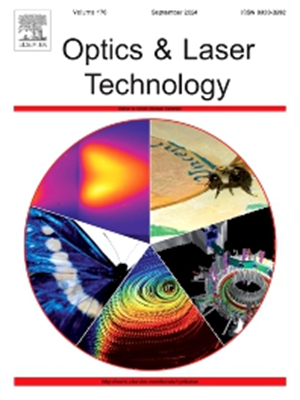Wearable optical fiber sensor in no-core fiber for heart rate monitoring
IF 5
2区 物理与天体物理
Q1 OPTICS
引用次数: 0
Abstract
Wearable heart rate (HR) sensors have gained remarkable progress in human vital signal monitoring and promoted the improvement of accurate medicine monitoring. The flexibility and stability are significant for wearable sensors, that determine the wearing comfort and signal accuracy. Here, a no-core fiber (NCF) based optical fiber sensor for precise continuous HR monitoring is presented. Two symmetric tapers are used to combine single mode fiber (SMF) and NCF, as well as improves the sensor’s robustness. The sensor probe exhibits a high bending sensitivity, reaching −10.346 dB/m−1 within a curvature range of 1.36–2.30 m−1, which is capable of detecting subtle bending signals with high accuracy. The sensor probe is integrated into a textile, an intensity demodulation system is created, pulse wave signal feature extraction and low-pass filtering signal processing algorithm are adopted, heartbeat signals are effectively real-time monitored for different positions (standing, sitting, and lying down) and different body parts (wrist, chest, and neck). The performance in comparison with commercial sensor demonstrates that the PCC is 0.958. With advantages of simple fabrication, high sensitivity, robustness, high stability, and wide applicability, the sensor holds a significant potential for human health monitoring.
用于心率监测的无芯光纤可穿戴光纤传感器
可穿戴式心率传感器在人体生命信号监测方面取得了显著进展,促进了精准医学监测的提高。可穿戴传感器的灵活性和稳定性决定着其佩戴舒适性和信号的准确性。本文提出了一种基于无芯光纤(NCF)的高精度连续HR监测光纤传感器。采用两根对称锥将单模光纤(SMF)和NCF结合在一起,提高了传感器的鲁棒性。该传感器探头具有很高的弯曲灵敏度,在1.36 ~ 2.30 m−1的曲率范围内可达到- 10.346 dB/m−1,能够高精度地检测细微弯曲信号。将传感器探头集成到织物中,构建强度解调系统,采用脉搏波信号特征提取和低通滤波信号处理算法,对不同体位(站、坐、卧)和不同身体部位(腕、胸、颈)的心跳信号进行有效实时监测。与商用传感器的性能比较表明,PCC为0.958。该传感器具有制作简单、灵敏度高、鲁棒性好、稳定性好、适用性广等优点,在人体健康监测中具有重要的应用潜力。
本文章由计算机程序翻译,如有差异,请以英文原文为准。
求助全文
约1分钟内获得全文
求助全文
来源期刊
CiteScore
8.50
自引率
10.00%
发文量
1060
审稿时长
3.4 months
期刊介绍:
Optics & Laser Technology aims to provide a vehicle for the publication of a broad range of high quality research and review papers in those fields of scientific and engineering research appertaining to the development and application of the technology of optics and lasers. Papers describing original work in these areas are submitted to rigorous refereeing prior to acceptance for publication.
The scope of Optics & Laser Technology encompasses, but is not restricted to, the following areas:
•development in all types of lasers
•developments in optoelectronic devices and photonics
•developments in new photonics and optical concepts
•developments in conventional optics, optical instruments and components
•techniques of optical metrology, including interferometry and optical fibre sensors
•LIDAR and other non-contact optical measurement techniques, including optical methods in heat and fluid flow
•applications of lasers to materials processing, optical NDT display (including holography) and optical communication
•research and development in the field of laser safety including studies of hazards resulting from the applications of lasers (laser safety, hazards of laser fume)
•developments in optical computing and optical information processing
•developments in new optical materials
•developments in new optical characterization methods and techniques
•developments in quantum optics
•developments in light assisted micro and nanofabrication methods and techniques
•developments in nanophotonics and biophotonics
•developments in imaging processing and systems

 求助内容:
求助内容: 应助结果提醒方式:
应助结果提醒方式:


